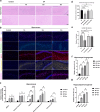NLRP3 inflammasome inhibits mitophagy during the progression of temporal lobe epilepsy
- PMID: 40348802
- PMCID: PMC12065917
- DOI: 10.1038/s41598-025-01087-y
NLRP3 inflammasome inhibits mitophagy during the progression of temporal lobe epilepsy
Abstract
Epilepsy is a neurological disorder involving mitochondrial dysfunction and neuroinflammation. This study examines the relationship between NLRP3 inflammasome activation and mitophagy in the temporal lobe epilepsy, which has not been reported before. A pilocarpine-induced epileptic rat model was used to assess seizure activity and neuronal loss. Pyroptosis markers (NLRP3, cleaved Gasdermin D, IL-1β/IL-18), and autophagy/mitophagy activity (LC3B-II/I, BNIP3, TOMM20/LC3B colocalization) were analyzed via immunofluorescence, Western blot, and transmission electron microscopy. NLRP3 inhibitors and anti-IL-1β antibodies were administered to evaluate therapeutic effects. Epileptic rats exhibited progressive neuronal loss and seizure aggravation, correlating with NLRP3 inflammasome activation and pyroptosis. While general autophagy was upregulated, mitophagy was selectively impaired in the hippocampus. NLRP3 activation promoted IL-1β release, which suppressed mitophagy via PPTC7 upregulation. NLRP3 activation inhibitor (MCC950) and anti-IL-1β treatment restored mitophagy and reduced seizures. NLRP3 inflammasome-driven pyroptosis exacerbates epilepsy by impairing mitophagy activity via IL-1β/PPTC7. Targeted NLRP3 inhibition mitigates this cascade, offering a promising strategy for refractory epilepsy.
Keywords: Autophagy; Mitophagy; NLRP3 inflammasome; Pyroptosis; Temporal lobe epilepsy.
© 2025. The Author(s).
Conflict of interest statement
Declarations. Ethics approval: The animal study was approved by the Animal Ethics Committee of Fujian Provincial Hospital, and all experimental procedures were performed according to the National Institutes of Health Guide for the Care and Use of Laboratory Animals. The authors complied with the ARRIVE guidelines. Competing interests: The authors declare no competing interests.
Figures





Similar articles
-
URB597 protects against NLRP3 inflammasome activation by inhibiting autophagy dysfunction in a rat model of chronic cerebral hypoperfusion.J Neuroinflammation. 2019 Dec 9;16(1):260. doi: 10.1186/s12974-019-1668-0. J Neuroinflammation. 2019. PMID: 31815636 Free PMC article.
-
SIRT1 alleviates IL-1β induced nucleus pulposus cells pyroptosis via mitophagy in intervertebral disc degeneration.Int Immunopharmacol. 2022 Jun;107:108671. doi: 10.1016/j.intimp.2022.108671. Epub 2022 Mar 16. Int Immunopharmacol. 2022. PMID: 35305383
-
Bergapten inhibits NLRP3 inflammasome activation and pyroptosis via promoting mitophagy.Acta Pharmacol Sin. 2023 Sep;44(9):1867-1878. doi: 10.1038/s41401-023-01094-7. Epub 2023 May 4. Acta Pharmacol Sin. 2023. PMID: 37142684 Free PMC article.
-
Regulation of the NLRP3 inflammasome by autophagy and mitophagy.Immunol Rev. 2025 Jan;329(1):e13410. doi: 10.1111/imr.13410. Epub 2024 Oct 17. Immunol Rev. 2025. PMID: 39417249 Review.
-
Mitochondrial dysfunction as a driver of NLRP3 inflammasome activation and its modulation through mitophagy for potential therapeutics.Int J Biochem Cell Biol. 2021 Jul;136:106013. doi: 10.1016/j.biocel.2021.106013. Epub 2021 May 19. Int J Biochem Cell Biol. 2021. PMID: 34022434 Review.
Cited by
-
Increased eosinophils after oral corticosteroid treatment for asthma exacerbation correlated with longer ER stays and persisting thymic stromal lymphopoietin and increased Park2.Sci Rep. 2025 Jul 3;15(1):23755. doi: 10.1038/s41598-025-07102-6. Sci Rep. 2025. PMID: 40610493 Free PMC article.
-
Inflammatory links between epilepsy and depression: a review of mechanisms and therapeutic strategies.Front Neurosci. 2025 Jun 26;19:1614297. doi: 10.3389/fnins.2025.1614297. eCollection 2025. Front Neurosci. 2025. PMID: 40641625 Free PMC article. Review.
References
-
- Bejarano, E. & Rodriguez-Navarro, J. A. Autophagy and amino acid metabolism in the brain: implications for epilepsy. Amino Acids. 47, 2113–2126 (2015). - PubMed
-
- Giorgi, F. S., Biagioni, F., Lenzi, P., Frati, A. & Fornai, F. The role of autophagy in epileptogenesis and in epilepsy-induced neuronal alterations. J. Neural Transm (Vienna). 122, 849–862 (2015). - PubMed
-
- Cao, L. et al. Vitamin E inhibits activated chaperone-mediated autophagy in rats with status epilepticus. Neuroscience161, 73–77 (2009). - PubMed
-
- Dong, Y. et al. Ascorbic acid ameliorates seizures and brain damage in rats through inhibiting autophagy. - PubMed
MeSH terms
Substances
Grants and funding
- 2021J05075/the Natural Science Foundation of Fujian Province, China
- 2021J05075/the Natural Science Foundation of Fujian Province, China
- 2021J05075/the Natural Science Foundation of Fujian Province, China
- 2023Y9286/Joint Funds for the innovation of science and Technology, Fujian province
- 2024J011004/Fujian Provincial Natural Science Foundation
LinkOut - more resources
Full Text Sources

